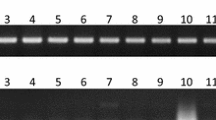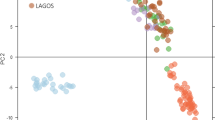Abstract
Jojoba (Simmondsia chinensis (Link) Schneider) is an obligate cross-pollinated shrub native to the Sonora desert. The most valuable product of the jojoba seeds is the liquid wax or jojoba oil which is marketed extensively in the cosmetic industry. Differing from the most of the cultivated crop species, jojoba has slow-growing habit, difficulties in the determination of sex at the early seedling stages, a male-biased ratio and low seed yield. In jojoba, the development of molecular strategies for the identification of sexes at early stages has been a priority in plantations and breeding programs. Two previous studies reported two candidate male-specific jojoba DNA markers. However, present study indicated that these markers were not useful in jojoba sex identification. A reliable gender diagnostic marker for jojoba is, therefore, needed. In the present study a novel jojoba male-specific touch-down polymerase chain reaction based DNA marker (JMS900) was reported using a total of 120 individual jojoba plants bulked into 16 samples. This sex specific DNA marker may have considerable theoretical and practical applications in the establishment of jojoba plantation and breeding studies.


Similar content being viewed by others
References
Agrawal V, Sharma K, Gupta S, Kumar S, Prasad M (2007) Identification of sex in Simmondsia chinensis (Jojoba) using RAPD markers. Plant Biotechnol Rep 1:207–210
Alstrom-Rapaport C, Lascoux M, Wang YC, Roberts G, Tuskan GA (1998) Identification of a RAPD marker linked to sex determination in the basket willow (Salix viminalis L.). J Hered 89:44–49
Bellirou A, Bouali A, Bouammali B, Boukhatem N, Elmtili BN, Hamal A, El-Mourabit M (2005) Extraction of simmondsin and oil in one step from jojoba seeds. Ind Crop Prod 21:229–233
Benzioni A, Vaknin Y (2002) Effect of female and male genotypes and environment on wax composition in jojoba. J Am Oil Chem 79:297–302
Benzioni A, Mills D, Van Boven M, Cokelaere M (2005) Effect of genotype and environment on the concentration of simmondsin and its derivatives in jojoba seeds and foliage. Ind Crop Prod 21:241–249
Benzioni A, Van Boven M, Ramamoorthy S, Mills D (2007) Dynamics of fruit growth, accumulation of wax esters, simmondsins, proteins and carbohydrates in jojoba. Ind Crop Prod 26:337–344
Chaves-Bedoya G, Nunenz V (2007) A SCAR marker for the sex types determination in Colombian genotypes of Carica papaya. Euphytica 153:215–220
Coates W, Ayerza R (2008) Supplemental pollination-increasing jojoba (Simmondsia chinensis L. [Schneider]) seed yields in the arid chaco environment. Ind Crop Prod 27:364–370
Culley TM, Wolfe AD (2000) Population genetic structure of the cleistogamous plant species Viola pubescens Aiton (Violaceae), as indicated by allozyme and ISSR molecular markers. Heredity 86:545–556
Danilova TV, Karlov GI (2006) Application of inter simple sequence repeat (ISSR) polymorphism for detection of sex-specific molecular markers in hop (Humulus lupulus L.). Euphytica 151:15–21
Dunstone RL, Benzioni A, Tonnet ML, Milthorpe P, Shani A (1985) Effect of temperature on the synthesis of jojoba wax. Aust J Plant Physiol 12:355–362
Ganeshaiah KN, Ravishankar KV, Anand L, Shibu MP, Shaanker U (2000) Identification of sex-specific DNA markers in the dioecious tree nutmeg (Myristica fragrans Houtt.). PGR Newsl 121:59–61
Gangopadhyay G, Roy SK, Ghose K, Poddar R, Bandyopadhyay T, Basu D, Mukherjee KK (2007) Sex detection of Carica papaya and Cycas circinalis in pre-flowering stage by ISSR and RAPD. Curr Sci 92:524–526
Gentry HS (1958) The natural history of Jojoba, Simmondsia chinensis and its culture aspects. Econ Bot 12:261–295
Harsh LN, Tiwari JC, Patwal DS, Meena GL (1987) Package and practice for cultivation of Jojoba Simmondsia chinensis in arid zone. Central Arid Zone Research Institute, Jodhpur, India
Hormaza JI, Dollo L, Polito VS (1994) Identification of a RAPD marker linked to sex determination in Pistacia vera using bulked segregant analysis. Theor Appl Genet 89:9–13
Ince AG, Karaca M, Onus AN (2009a) Development and utilization of diagnostic DAMD-PCR markers for Capsicum accessions. Genet Resour Crop Evol 56:211–221
Ince AG, Karaca M, Onus AN (2009b) Genetic relationships within and between Capsicum species. Biochemical Genetics. doi:10.1007/s10528-009-9297-4
Jiang L, You RL, Li MX, Shi C (2003) Identification of a sex associated RAPD marker in Ginkgo biloba. Acta Bot Sin 45:742–747
Kafkas S, Cetiner S, Perl-Treves R (2001) Development of sex-associated RAPD markers in wild Pistacia species. J Hort Sci Biotechnol 76:242–246
Karaca M, Ince AG (2008) Minisatellites as DNA markers to classify bermudagrasses (Cynodon spp.): confirmation of minisatellite in amplified products. J Genet 87:83–86
Karaca M, Saha S, Zipf A, Jenkins JN, Lang DJ (2002) Genetic diversity among forage bermudagrass (Cynodon spp.): evidence from chloroplast and nuclear DNA fingerprinting. Crop Sci 42:2118–2127
Karaca M, Saha S, Callahan FE, Jenkins JN, Read JJ, Percy RG (2004) Molecular and cytological characterization of a cytoplasmic-specific mutant in pima cotton (Gossypium barbadense L.). Euphytica 139:187–197
Karaca M, Ince AG, Elmasulu SY, Onus AN, Turgut K (2005) Coisolation of genomic and organelle DNAs from 15 genera and 31 species of plants. Anal Biochem 343:353–356
Karaca M, Ince AG, Ay ST, Turgut K, Onus AN (2008) PCR-RFLP and DAMD-PCR genotyping for Salvia species. J Sci Food Agric 88:2508–2516
Khadka DK, Nejidat A, Tal M, Golan-Goldhirsh A (2002) DNA markers for sex: molecular evidence for gender dimorphism in dioecious Mercurialis annus L. Mol Breeding 9:251–257
Kumar PP, Arumuganathan K (1997) Estimation of nuclear DNA content of various bamboo and rattan species. In: Rao AN, Rao VR (eds) Bamboo and rattan genetic resources and use. International Plant Genetic Resoures Institute, Serdang, Malaysia, pp 195–203
Lemos EGM, Silva CLSP, Zaidan HA (2002) Identification of sex in Carica papaya L. using RAPD markers. Euphytica 127:179–184
Mandolino G, Carboni A, Forapani S (1999) Identification of DNA markers linked to the male sex in dioecious hemp (Cannabis sativa L.). Theor Appl Genet 98:86–92
Prakash S, Van Staden J (2006) Sex identification in Encephalartos natalensis (Dyer and Verdoorn) using RAPD markers. Euphytica 152:197–200
Prakash S, Agrawal V, Gupta SC (2003) Influence of some adjuvants on in vitro clonal propagation of male and female jojoba plants. In Vitro Cell Dev Biol Plant 39:217–222
Purcell HC, Abbott TP, Holser RA, Phillips BS (2000) Simmondsin and wax ester levels in 100 high-yielding jojoba clones. Ind Crop Prod 12:151–157
Radwan MS, Ismail MA, Elfeky SMS, Abu-Elyazeed OSM (2007) Jojoba methyl ester as a diesel fuel substitute: preparation and characterization. Appl Therm Eng 27:314–322
Ruas CF, Fairbanks DJ, Evans RP, Stutz HC, Andersen WR, Ruas PM (1998) Male-specific DNA in the dioecious species Atriplex garrettii (Chenopodiaceae). Am J Bot 85:62–167
Sharma K, Agrawal V, Gupta S, Kumar R, Prasad M (2008) ISSR marker-assisted selection of male and female plants in a promising dioecious crop: jojoba (Simmondsia chinensis). Plant Biotechnol Rep 2:239–243
Tan H, Callahan FE, Zhang XD, Karaca M, Saha S, Jenkins JN, Creech RG, Ma DP (2003) Identification of resistance gene analogs in cotton (Gossypium hirsutum L.). Euphytica 134:1–7
Tobares L, Frati M, Guzman C, Maestri D (2004) Agronomical and chemical traits as descriptors for discrimination and selection of jojoba (Simmondsia chinensis) clones. Ind Crop Prod 19:107–111
Torjek O, Buchema N, Kiss E, Homoki H, Finta-Korpelova Z, Bocsa I, Nagy I, Heszky LE (2002) Novel male-specific molecular markers (MADC5, MADC6) in hemp. Euphytica 127:209–218
Ulger S, Akdesir O, Baktır I (2002) Selection of promising jojoba (Simmondsia chinensis Link Schneider) types in terms of yield and oil content. Turk J Agric For 26:319–322
Urasaki N, Tokumoto M, Tarora K, Ban Y, Kayano T, Tanaka H, Oku H, Chinen I, Terauchi R (2002) A male and hermaphrodite specific RAPD marker for papaya (Carica papaya L.). Theor Appl Genet 104:281–285
Van Boven M, Busson R, Cokelaere MM, Flo G, Decuypere E (2000) 4-Demethyl simmondsin from Simmondsia chinensis. Ind Crop Prod 12:203–208
Xu WJ, Wang BW, Cui KM (2004) RAPD and SCAR markers linked to sex determination in Eucommia ulmoides Oliv. Euphytica 136:233–238
Yang H, Gan SM, Yin GT, Xu HC (2005) Identification of random amplified polymorphic DNA markers linked to sex determination in Calamus simplicifolius C. F. Wei. J Integr Plant Biol 47:1249–1253
Acknowledgments
This research is supported by the Scientific Research Projects Administration Unit of Akdeniz University and The Scientific and Technological Research Council of Turkey. We also thank Dr. Ozgur Akdesir for providing the plant materials used in this study.
Author information
Authors and Affiliations
Corresponding author
Rights and permissions
About this article
Cite this article
Ince, A.G., Karaca, M. & Onus, A.N. A reliable gender diagnostic PCR assay for jojoba (Simmondsia chinensis (Link) Schneider). Genet Resour Crop Evol 57, 773–779 (2010). https://doi.org/10.1007/s10722-009-9516-1
Received:
Accepted:
Published:
Issue Date:
DOI: https://doi.org/10.1007/s10722-009-9516-1




